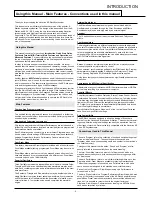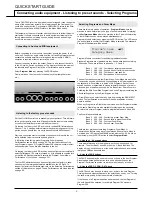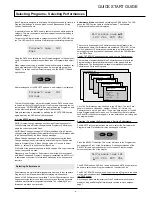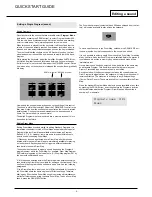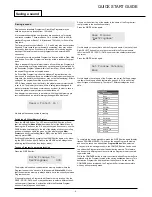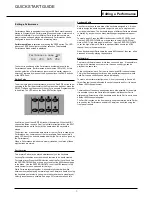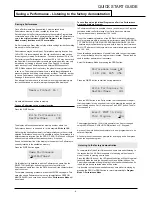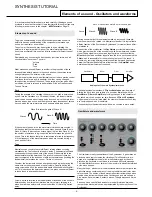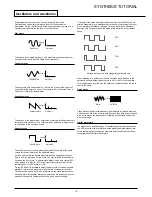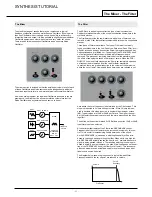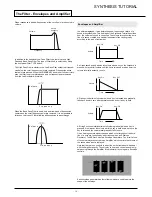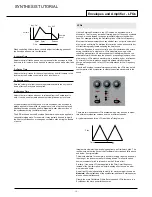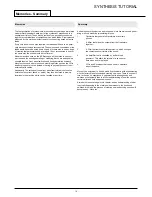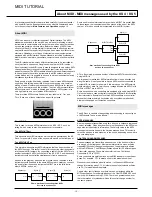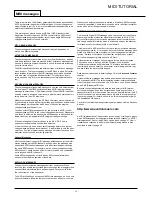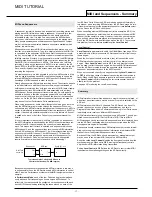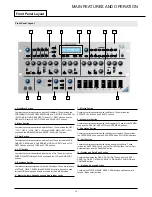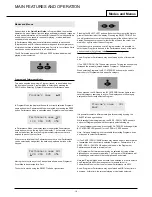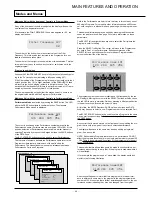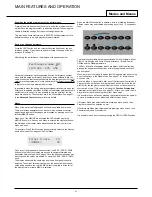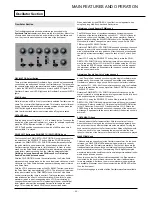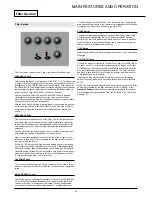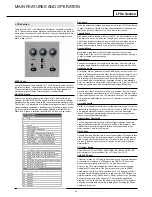
The diagrams below show how these waveforms look on an
Oscilloscope and illustrate the relative levels of their harmonics.
Remember, it is the relative levels of the various harmonics present in a
waveform which determine the tone of the final sound.
Sine waves
These have just a single frequency. This waveform produces the purest
sound because it only has this single pitch (frequency).
Triangle waves
These contain only odd harmonics. The volume of each is the square of
its position in the harmonic series. For example, the 5th harmonic has a
volume of 1/25th of the fundamental.
Sawtooth waves
These have a rich proportion of harmonics, containing all the harmonics of
the fundamental frequency. The volume of each harmonic is proportional
to its position in the harmonic series.
Square waves
These only have only the odd harmonics present. These are at the same
volume as the odd harmonics in a sawtooth wave.
It will be noticed that the square waveform spends an equal emount of
time in its ‘high’ state and its ‘low’ state. The way in which this defined is
known as the ‘duty cycle’. A square wave always has a duty cycle of 50%
which means it is ‘high’ for 50% of the waveform cycle and ‘low’ for the
remaining 50% of the waveform cycle.
On the KS Rack it is possible to adjust the duty cycle of the basic square
waveform to produce a waveform which is more ‘rectangular’ in shape.
These are often known as Pulse waveforms. As the waveform becomes
more and more rectangular, more even harmonics are introduced and the
waveform changes its character, becoming more ‘nasal’ sounding.
The width of the pulse waveform (often known as ‘Pulse Width’) can be
altered dynamically by a modulator which results in the harmonic content
of the waveform constantly changing. This can result in the waveform
having a very ‘fat’ quality when the pulse width is altered at a moderate
speed.
When listening to a pulse wave, it does not make any difference to the
percieved sound whether the duty cycle is 40% or 60% since the wave-
form has just been inverted and the harmonic content between the two is
exactly the same.
Noise waves
These have no fundamental frequency (and therefore no pitched element).
All frequencies are at the same volume. Because they have no perceivable
pitch, noise waves are often useful for creating sound effects and percus-
sion type sounds.
Digital waveforms
In addition to the traditional types of Oscillator waveforms detailed above,
the KS Rack also offers carefully selected digitally sampled preset wave-
forms containing useful harmonic elements normally difficult to produce
using traditional Oscillator waveforms.
SYNTHESIS TUTORIAL
Oscillators and waveforms
•
10
•
Volume
Harmonic
1
Sine Wave
Sine Wave
Harmonic
Volume
Volume
Harmonic
1
3
5 7
Triaangle Wave
Triangle Wave
Harmonic
Volume
Sawtooth Wave
Volume
Harmonic
1
2
3
4
5
Sawtooth Wave
Harmonic
Volume
Square Wave
Volume
Harmonic
1
2
3
4
5
Square Wave
Harmonic
Volume
50%
40%
10%
60%
Various duty cycles of rectangular (pulse) waves
Noise
Volume
Harmonic
1
2
3
4
5
Noise
Harmonic
Volume


